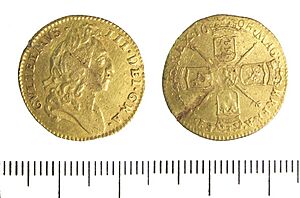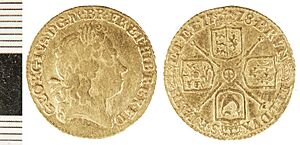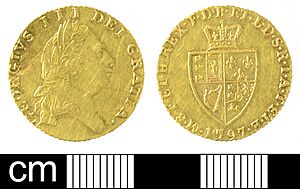Half guinea facts for kids
The half guinea was a special gold coin first made in 1669 for the Kingdom of England and later for Great Britain. It came out a few years after the larger Guinea coin. The half guinea was officially stopped in the Great Recoinage of 1816. However, like the guinea, people still used its name when talking about prices even after new money systems came in.
Contents
- What Was a Half Guinea Worth?
- History of the Half Guinea Coin
- Charles II's Half Guinea (1669-1684)
- James II's Half Guinea (1686-1688)
- William and Mary's Half Guinea (1689-1694)
- William III's Half Guinea (1695-1701)
- Queen Anne's Half Guinea (1702-1714)
- George I's Half Guinea (1715-1727)
- George II's Half Guinea (1727-1760)
- George III's Half Guinea (1760-1820)
- When the Half Guinea Was Replaced
- See also
What Was a Half Guinea Worth?

The value of the guinea coin changed a lot over the years. It went from twenty shillings to thirty shillings, then back down to twenty-one shillings and sixpence. This happened by the time King George I started his rule.
In December 1717, a Royal Proclamation (a public announcement from the king) officially set the guinea's value at twenty-one shillings. This meant the half guinea was worth exactly ten shillings and sixpence. This was often written as 10s. 6d. or 10/6.
A half guinea coin weighed about 4.2 grams. Today, a half guinea from 1717 would be worth around £0.50 in buying power. However, a real gold half guinea in good condition would be worth much more to collectors.
History of the Half Guinea Coin
Charles II's Half Guinea (1669-1684)
The first half guineas were made during the reign of King Charles II. From 1676 to 1684, some of these coins had a special elephant and castle symbol. This symbol showed that the gold came from the Africa Company.
The coin weighed 4.2 grams and was 20 millimeters wide. John Roettier designed both sides of this coin. The front side, called the obverse, showed King Charles II facing right. He wore a Laurel wreath on his head. Around him, it said "CAROLVS II DEI GRATIA," which means "Charles II by the Grace of God."
The back side, called the reverse, had four crowned shields. These shields showed the symbols (arms) of England, Scotland, France, and Ireland. Four scepters (royal staffs) were placed between the shields. In the middle, there were four linked "C" letters. The words around the edge said "MAG BR FRA ET HIB REX date," meaning "King of Great Britain, France, and Ireland."
To stop people from cutting off small pieces of gold, the edge of the coin had special grooves. In 1669, these grooves went straight up and down. From 1670, they went diagonally across the edge.
James II's Half Guinea (1686-1688)
John Roettier also designed the half guinea coins for King James II. These coins were the same size and weight as before. They were made from 1686 to 1688.
Only a few coins made in 1686 had the elephant and castle mark, making them quite rare. On these coins, King James II faced left. The words around his head said "IACOBUS II DEI GRATIA." The back of the coin was similar to Charles II's design, but it did not have the linked "C" letters in the center. The edges of these coins also had diagonal grooves.
William and Mary's Half Guinea (1689-1694)
After James II was removed in 1688, his daughter Mary and her husband Prince William of Orange ruled together. Their heads appeared joined together on the half guinea, like in Roman art. William's head was on top. The words around them said "GVLIELMVS ET MARIA DEI GRATIA."
The back of the coin had a completely new design. It showed a large crowned shield. This shield had the arms of France, Scotland, Ireland, and England in different sections. In the very center, there was a small shield with the lion symbol of Nassau (William's family). The words on the back said "MAG BR FR ET HIB REX ET REGINA date," meaning "King and Queen of Great Britain, France, and Ireland."
During this time, the value of a guinea coin went up to almost thirty shillings. The half guineas weighed 4.2 grams and were 20 millimeters wide. Half guineas were made every year from 1689 to 1694. Some coins from 1691 and 1692 also featured the elephant and castle mark.
William III's Half Guinea (1695-1701)
After Queen Mary died in 1694, William continued to rule as William III. Half guinea coins were made every year from 1695 to 1701. Some coins from 1695, 1696, and 1698 had the elephant and castle symbol.
These coins also weighed 4.2 grams and were 20 millimeters wide. William's head faced right on his coins. The words around his head said "GVLIELMVS III DEI GRATIA." The design on the back of the coin went back to how it was for Charles II and James II. It had the four crowned shields, but with the small Nassau lion shield in the center. The words on the back said "MAG BR FRA ET HIB REX date." The edge of the coin had diagonal grooves.
Queen Anne's Half Guinea (1702-1714)
During the reign of Queen Anne, half guineas were made in 1702, 1703, and 1705 before England and Scotland officially joined. The 1703 half guinea is special because it has the word "VIGO" under the Queen's head. This showed that the gold came from Spanish ships captured at the Battle of Vigo Bay.
After England and Scotland united to form Great Britain, the design on the back of the half guinea changed. Before the Union, the shields on the back showed the arms of England, Scotland, France, and Ireland separately. After the Union, the arms of England and Scotland were joined together on one shield. The coins still weighed 4.2 grams and were 20 millimeters wide. The edge had diagonal grooves.
George I's Half Guinea (1715-1727)
King George I's half guinea coins were made between 1715 and 1727, except for 1716. Some coins from 1721 had the elephant and castle mark. These coins also weighed 4.2 grams and were 20 millimeters wide. Their edges had diagonal grooves.
The front of the coin showed the king facing right. The words around him said "GEORGIVS D G M BR FR ET HIB REX F D." This means "George, by the Grace of God, King of Great Britain, France, and Ireland, Defender of the Faith." The back of the coin was similar to earlier designs. However, the shields now showed England+Scotland, France, Ireland, and Hanover (a German territory that George I also ruled). The words on the back were a long Latin phrase that explained his titles as Duke of Brunswick and Lüneburg, and Elector of the Holy Roman Empire.
George II's Half Guinea (1727-1760)
King George II's half guinea coins had many different designs over his 33-year reign. They were made in most years, but not in 1735, 1741, 1742, 1744, 1754, and 1757. The coins weighed 4.2 grams and were 20 millimeters wide.
Some coins made between 1729 and 1739 had the letters "EIC" under the king's head. This meant the gold came from the British East India Company. Some 1745 coins had the word "LIMA" to show that the gold came from Admiral Anson's famous trip around the world. The edge of these coins had diagonal grooves.
The front of the coin showed the king facing left. The words around him said "GEORGIVS II DEI GRATIA." The back of the coin had one large crowned shield. This shield showed the arms of England+Scotland, France, Hanover, and Ireland. The words on the back were a long Latin phrase, similar to George I's coin, listing his many titles.
George III's Half Guinea (1760-1820)
The half guinea was made in almost every year of King George III's very long reign. These coins weighed 4.2 grams. From 1787, they were 20-21 millimeters wide.
All the front sides of George III's coins showed him facing right, but with different portraits as he aged. The words around him always said "GEORGIVS III DEI GRATIA." The back of the half guineas made between 1761 and 1786 showed a crowned shield with the arms of England+Scotland, France, Ireland, and Hanover.
In 1787, a new design for the back was introduced. It featured a spade-shaped shield. This coin became known as the Spade Half-Guinea.
In 1774, nearly 20 million old guinea coins from William III and Queen Anne were melted down. This gold was then used to make new guineas and half-guineas.
In 1801, King George III gave up his claim to the French throne. Because of this, the words on the back of the coin changed. The Hanoverian arms were also removed from the shield. The back of the 1801-1813 half guinea had a crowned shield inside a Garter (a special belt symbol). The Garter had the words "HONI SOIT QUI MAL Y PENSE" (a French phrase meaning "Evil to him who evil thinks"). Around the edge, it said "BRITANNIARUM REX FIDEI DEFENSOR," meaning "King of the Britains, Defender of the Faith."
When the Half Guinea Was Replaced
In the Great Recoinage of 1816, the half guinea coin was replaced by a new coin called the half sovereign. The half sovereign was also worth 10 shillings, just like the half guinea.
See also
- For other types of coins, see British coinage





